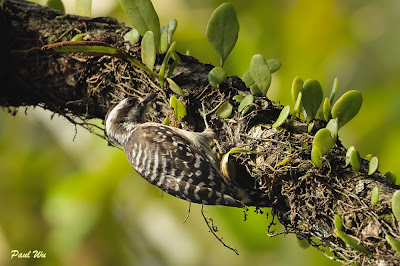Three weeks of acquaintance with the CHE has made the adult dark morph more approachable and friendly towards my presence. Now I am able to walk around the nesting site and shoot right below the perch without scaring it off. The CHE probably think I am the new owner of this durian plantation!
The dark morph's daily routine was the same on all my observations so far, perch on the nest or near the nest silently for hours between 3-7pm, by 6-7pm, it would call for the white morph to return. I was touched to see on a few occasion that when the harsh sunlight is hitting the chick in the afternoon, the adult would shelter the chicks for as long as the sunlight is out.
Feeding so far is only by the dark morph. One interesting note is the carrion is always being carried to a nearby tree, tear into pieces before bringing back to feed both the chick and itself. Perhaps the adult do not want the blood to stain the nesting, or it needs a solid branch to tear the body apart hence without risking the structural rigidity of the nest.
A short video recorded on the 30th of March
The dark morph's daily routine was the same on all my observations so far, perch on the nest or near the nest silently for hours between 3-7pm, by 6-7pm, it would call for the white morph to return. I was touched to see on a few occasion that when the harsh sunlight is hitting the chick in the afternoon, the adult would shelter the chicks for as long as the sunlight is out.
Feeding so far is only by the dark morph. One interesting note is the carrion is always being carried to a nearby tree, tear into pieces before bringing back to feed both the chick and itself. Perhaps the adult do not want the blood to stain the nesting, or it needs a solid branch to tear the body apart hence without risking the structural rigidity of the nest.
A short video recorded on the 30th of March
The pale morph on the other hand is still behaving cautious, and every time it shows up in late afternoon , I have to retreat to the hut/shelter or else it won't perch on the nest. I begin to wonder now which morph is the male and which is the female On the physical size, the dark morph is slightly larger than the pale morph.
And the chick looked more like the serious Nikon-black now than the previously chubby Canon-white! So a welcoming sight of course! :)
Pic abv (taken with PnS on 90mm zoom) show my close range with the adult dark morph, ~25' away.
And below are the pic taken in my last trip, the adult, surprisingly, was 10' below the nesting for almost two hours.
There are more species occur in this 10-acre durian plantation than i had previously thought. And finally i managed to get the shot of the Banded Bay Cuckoo (lifer)! There are 4 of them here but unfortunately opportunity for a close and low perch shot was not given. Extremely responsive to play calls in the late afternoon or early morning.
And last week, an experienced birder joined me for the shoot, said he heard the calls of Plaintiff Cuckoo! Now I hate him for telling me that because it looks like I will be busy visiting here after the fledging of the CHE's chick
And I ought to come often because two pairs of the White-collared Kingfishers have started nesting, at least 2 Spotted Wood Owl were seen in the last three weeks, ok I need better shot of the Black-naped Oriole.........
Banded Bay Cuckoo
Asian Brown Flycatcher,
Collared Kingfisher
Common Iora
Pied Thriller
Sunda Woodpecker
Zebra Dove
White-breasted Waterhen
female Pink-necked Green Pigeon
And I need help for this species, taken last week in the durian plantation. I am still unable to ID from my sources. It was seen twice near the stream, perch like a flycatcher. and so far I have never heard its calls.
Any suggestion will be appreciated!
The owner keeps an 'army' of 8 dogs here help keep the monkeys and uninvited guests away. This puppy was named "Southern Wings" by me, because he is the only dog that would stay by my side for hours..


























Wonderful work Paul, a real joy to read and view your photos...
ReplyDeleteWow my eyes are just out of their socket!!! What a wonderful and enjoyable post you are offering us... So many good pictures that I do not even know which one if my fav if I had to choose one, I could not!!! Wonderful set Paul!
ReplyDeleteJust added your blog to my side bar today. The hawk story is very nice and so similar to what I follow. I am inclined to think that the larger dark morph is most assuredly the female, since they usually run the nest the longer hours and are larger in size. I have found the females to be more relaxed after the initial hatching of chicks, and that the males tend to be more wary. Your blog is very lovely~
ReplyDeleteThanks Ari, Chris & Mary!
ReplyDelete>Mary, thank you so much for your comments. I was biased initially into thinking the pale morph being female because it looked pretty compared to the dark morph! :)
Very niche.
ReplyDeletewhen are they going to have Tupai for meal?
What a fantastic trip, love the new banner...and hope to see more soon.
ReplyDeleteHi Paul
ReplyDeleteI think the mystery bird may be a Mangrove Whistler (not only seen in mangroves!)
>digdeep, thanks and that also concur with Ingo's suggestion! Another tick for me! :)
ReplyDelete